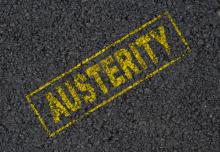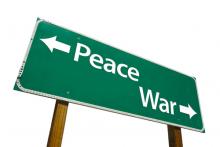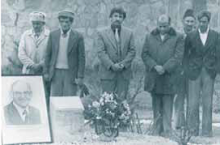Commentary

IN AMERICA, WE honor the ideal of equality and the myth of equal opportunity—but the secret we refuse to acknowledge is the debilitating, dehumanizing effects of poverty. As a pastor serving the South Side of Chicago, I witness firsthand the pain that poverty inflicts upon our congregation and the scars it leaves on the most vulnerable: children. Faith in Christ should mean a commitment to the poor.
There is a growing wealth gap between African-American households and white households. A Pew research study, for example, shows the dramatic change between 2005 and 2009. In 2005, the typical white household had a net worth of $134,992 (in 2009 dollars), while the typical black household had a net worth of $12,124—9 cents for each dollar the white household owned. By 2009, that fell to 5 cents, as the typical black household saw its net worth drop more than 53 percent, as compared to a drop of 16 percent for the average white household. And, alarmingly, 35 percent of black households in 2009 had a zero or negative net worth.
A few seek to blame this damaging downward trend on the current administration's policies. This is unfair and incorrect. Black families have traditionally built wealth through homeownership, but since the mid-1990s we have witnessed a dramatic increase in bank mergers—and predatory lending. Local banks, now owned by large corporate institutions with little interest in community investment, increasingly close branches in poor communities, then check-cashing establishments fill the void in financial services. At the same time, our nation faces the loss of manufacturing and the dismantling of organized labor. The triple threat of regressive economic policy, unchecked expansion of large, unaccountable financial institutions, and the economic crisis of 2008 devastated parts of cities across the nation: Chicago, Cleveland, Detroit, Atlanta, New York, Buffalo, Flint, and many others.

IN THE EARLY weeks of the Eastertide lectionary, there appears a series of texts from the third and fourth chapters of Acts ... Peter and John, on their way to temple prayers, heal a man begging at the beautiful gate. His joy begets a sermon from Peter on the resurrection, at the close of which the disciples are arrested and spend the night in jail. The next day in court they again testify boldly, refuse to comply with the court's order, and are released after calculated threats from the authorities. Their release prompts prayers of thanksgiving in the community.
OVER THE PAST few years, we have seen tangible proof that creation is terribly off balance. Global warming is causing droughts and heat waves around the world and is making hurricanes more powerful. In my hometown of New York City, we have experienced the effects of severe weather: Hurricane Irene in 2011 and, most recently, the devastation of Hurricane Sandy. Sandy was an eye-opening demonstration that climate change is a poverty issue, a race issue, and an immigration issue.
Though neighborhoods of all socioeconomic statuses were affected by Sandy, poorer communities are taking longer to recover. Many of them were without electricity, heat, and water longer than were more affluent communities. For instance, residents of Red Hook's public housing projects in Brooklyn were without power and water for two weeks after the storm. My cousin Dabriah Alston, a Red Hook resident, told me that the city ignored residents' repeated requests for information about when the heat would come back on: "The bottom line is, they don't care about us. Projects are filled with poor folk, and as we all know, the poor are seldom a priority."
Hurricane Sandy shone an uncomfortable light on racial and economic disparity in New York City. As someone who was born and raised in Brooklyn, I am very familiar with Red Hook's history of poverty, and the neglect by local government. For example, only when the community near the housing projects began to gentrify did the city start to repair the nearby subway station.
Sandy also exposed how, in the city that is home to Ellis Island, immigrants live in an environment of fear. Although families of mixed immigration status qualify for some FEMA disaster assistance, and families of any status qualify for emergency food aid, many did not apply for it because they feared deportation, as I learned at a post-Sandy meeting of the Occupy Faith group. The environment of fear magnified the impact that the hurricane had already had on the poor: Many immigrants are non-salaried workers who missed a week of their already-low wages due to the hurricane.

AS THE U.S. Congress and the president repeatedly battle over the debt ceiling and contemplate cuts to Social Security and Medicare, austerity has begun to sound like common sense: "Families tighten their belts during hard times, and so must government."
However, "common sense" in our media age is carefully manufactured, and its underlying analogy doesn't always hold up to scrutiny. "Living within our means," for most families, includes debt financing for housing, cars, and college. Families having a hard time paying their bills may indeed tighten their belts—but they seek more income first, and cut care for children and the sick last. In contrast, federal budget austerity arguments always focus on spending, ignoring the revenue crisis born of decades of tax cuts.
Christians have a more profound reason to question "austerity measures": They conflict with our faith in God's abundance. In parable after parable—the prodigal son, the unforgiving debtor, Lazarus and the rich man—Jesus challenges us to emulate God's generosity. It is the theme of that most eucharistic miracle, the loaves and fishes. How to live in the light of God's abundance is never an easy question, but we must be open to its logic in every area of human existence, including our personal lives, our economy, and our government.
There is, needless to say, a deep contrast between Christian notions of abundance, rooted in God's boundless creative gift, and the modern field of economics, which bases itself on the principle that commodities are scarce. Yet there are also resonances between abundance and modern macroeconomics (the study of whole economies) as it developed in the New Deal period and the first three decades after World War II—especially in the great postwar era of shared prosperity, which saw an explosive expansion of the middle class.
During that period, everyone gave to the national common good, and everyone received—not just through strongly redistributive taxation, but through shared, unprecedented economic growth. And it wasn't simply the "invisible hand" of the marketplace that guided growth: The market was fostered by government's investment in infrastructure and education.

WHEN POPE BENEDICT XVI unexpectedly announced his resignation in mid-February, many expressed admiration for the decision's honesty and humility, and much speculation followed about the reasons for it—and the consequences it would have.
As transition takes shape in the Vatican, Catholics around the world are commemorating the 50th anniversary of the Second Vatican Council, which took place from 1962 to 1965 and which redefined the church's relationship to the world. Vatican II's final document said: "This council can provide no more eloquent proof of its solidarity with, as well as its respect and love for the entire human family with which it is bound up, than by engaging with it in conversation about these various problems," referring in part to the "profound and rapid changes ... spreading by degrees around the whole world." Half a century ago, few could have predicted the dramatic changes that were to follow in science, technology, global integration, and social mores.
Catholics know that in the last 50 years the institutional church has been at the forefront of calls for a more just, compassionate, and sustainable world. Catholic social and ecological teaching is well developed and clearly articulated. The church has offered analysis and challenging proposals for financial reform, arms control, care for creation, and multilateral political structures of accountability in response to globalization.
We want the new pope to continue, deepen, and make much more visible—including to Catholics around the world—the church's prophetic work for social and economic justice, for environmental sustainability, and for wise, just, and inclusive peace. We want the new pope to engage the Islamic world, respectfully cooperating in response to orchestrated fear, enemy-making, and all forms of religious extremism. We want him to promote cultures of peace in a world that is increasingly violent. We want him to be open to new cosmological insights that are transforming human consciousness; shifting our understanding of earth community and of our planet's place in the vast, expanding universe; and maturing our reflections on the One who is Creator, Incarnation, and Spirit of love.
IN A CROWDED auditorium [in Honduras after Hurricane Mitch] that served as a shelter for 900 people, the scarce supply of drinking water was kept in a bucket and labeled with a sign that said "Do not use your own cup." Five bored, mischievous children, however, could think of nothing better than to try to stick their cups in the water. Then one relief worker gave them a special assignment. "This water is very important," she said. "I need you to be the guardians of the water so that no one dips in their own glass." And they, feeling respected and needed, became the fierce, undaunted protectors of the water supply.
Similarly, countless Hondurans are saying, "If not us, then who?"—righting their relationship with themselves, assuming the task of rebuilding their homes and communities, recognizing that progress occurs when they participate. Women, who have never even valued their never-ending activity as work, are speaking up when the pay sheets are evaluated. "I planted a garden. I rebuilt the wall of my house. I earned my corn and beans."
ONE EVENING LAST July, I walked up to the Port Everglades U.S. border checkpoint in Fort Lauderdale, Fla., to intentionally turn myself in to U.S. Customs and Border Protection. My mission: to get into Broward Transitional Center, a privately run U.S. Immigration and Customs Enforcement (ICE) detention facility, to expose the stories of those held there. It's categorized by ICE as a model facility. But as I witnessed firsthand, it is nothing short of a prison where, as in the other 250 immigration prisons across the U.S., immigrants are arbitrarily held and exposed to all kinds of human rights abuses.
The total number of undocumented immigrants detained in the U.S. each year is sky-high—ICE detained 429,247 people in 2011 alone. In August 2011, the administration announced that it would focus its deportation efforts on people with criminal records. "Obama is only deporting gangbangers and felons," established immigrant advocacy organizations said. "He's our guy for immigration reform!"
But that is far from true. In my work with the National Immigrant Youth Alliance (NIYA), I keep hearing the real stories of immigrant prisoners and the loved ones from whom they're torn.
Getting detained was part of a strategy of civil disobedience that fellow activists and I have been pursuing since 2010: In order to pressure ICE and the government, we have to put ourselves on the line. I was one of two Youth Alliance activists who sought to infiltrate the Broward Center to find out the inside story. We also set up a telephone hotline, funded by donations from the community, to take calls from people detained in the center.
BETWEEN 2008 and 2009, the Centers for Disease Control reported in November, the U.S. abortion rate fell 5 percent, down to the lowest point that decade. This new data is drawing the attention of people of faith whose thinking about unwanted pregnancies has become more nuanced—both in how to prevent them and what to do when they occur.
Why did the rate drop? It's not a matter of people being more cautious about becoming pregnant due to the recession; along with the overall decline, the number of abortions per 1,000 live births also dropped. But it might be linked to the fact that use of long-acting contraceptives such as IUDs, which tend to be more effective than other methods, more than doubled from 2007 to 2009, according to a national survey.
In recent years, as evangelical activism has broadened, economic justice, creation care, and immigration reform have been at the forefront of the change—but abortion hasn't. Of evangelicals, 61 percent believe abortion should be illegal in all or most cases, while 33 percent say it should be legal; 84 percent of evangelicals ages 18 to 30 say they would not consider abortion if faced with an unexpected pregnancy.
While 77 percent of those young evangelicals find premarital sex unacceptable, they are also aware of facts on the ground, perhaps because they think seriously about human fallenness. Eighty-two percent, perhaps with the awareness that more-effective birth control would reduce abortion rates further, hold that those having "sex outside of marriage should use contraceptives to prevent pregnancy." (An increasing number of Catholics hold similar views, despite current church teaching.)

WITH A ONE-TWO punch, 2012 was bracketed by the speedy and unexpected adoption of so-called "right-to-work" laws to undermine labor unions in two Midwestern states—Indiana and Michigan. That was preceded in 2011 by other bad news for labor: frontal assaults on public employee unions in Wisconsin and in Ohio. The assault in Wisconsin succeeded despite the political firestorm it generated, but Ohio voters overrode the efforts of their governor and legislators to gut public-employee bargaining rights.
Yes, the labor wars are on full force in the Midwest—and they are challenging faith communities to dig back into their teachings about the dignity of work, the rights of workers, and the pursuit of justice.
Bishop Thomas Gumbleton, retired auxiliary bishop of the Catholic archdiocese of Detroit, minced no words in his article for the Kalamazoo Gazette in mid-December. "Right-to-work laws go against everything we believe," he wrote. "At the core of Christianity, Judaism, Islam, and all great religions are the values of dignity and respect, values from which economic justice and the right to organize can never be separated."
The phrase "right to work" sounds noble, but these laws are not about guaranteeing anyone meaningful employment. Instead, they prohibit union contracts with employers from requiring non-union employees—who benefit from the union's work negotiating wages and benefits—to pay dues in recognition of that fact.

IN THE U.S., the Cold War has served to justify a permanent wartime economy, blacklisting and surveillance of dissenters, and military interventions against smaller and weaker nations from Vietnam to Nicaragua. In the Soviet Union, it has been used to excuse a permanent state of economic austerity, the imprisonment and torture of dissenters, and military interventions from Hungary to Afghanistan. And on both sides the Cold War has provided the ideological underpinning and political momentum for a nuclear arms race that threatens the future of the entire human family. ...
As Christians our faith, security, and hope for a peaceful world can only be placed in the one true God, who is the creator and sustainer of all life and the Lord of history. The first and most essential commandment forbids us to trust the fate of God’s earth and generations unborn to the creations of finite, fallible, and fallen human beings.

LAST OCTOBER, A historic breakthrough for peace took place in Mindanao. In this region in the southern Philippines, an armed conflict has persisted for more than four decades, killing 120,000 people and displacing millions. Now, after 15 years of peace negotiations between the government of the Philippines and the Moro Islamic Liberation Front, both sides have signed a framework peace agreement.
For generations, Moro (as traditionally Islamic ethnic groups are called here) and indigenous peoples in Mindanao have been politically, economically, and socially left out and marginalized in the Philippines. It is in this context—and the collective desire of the Moro people in Mindanao for self-governance—that both the armed conflict and the peace negotiations took place. The agreement signed in October outlines a pathway toward the establishment of a political entity, Bangsamoro, that will be autonomous, although not fully independent of the Philippines.
The framework agreement is a welcome consolidation of a long-term peace process that has encountered significant challenges, including periods of lackluster support from the international community and a less-than-successful 1996 peace agreement with the Moro National Liberation Front (from which the Moro Islamic Liberation Front is a breakaway group).
TAMAR’S LIFE COULD have been different. A princess of David’s kingdom, she would have married into a wealthy family. But that all changed with the only recorded event of her life, described in 2 Samuel 13: A family member forced himself on her, then turned her out of his room. She cried aloud for all to hear, but the one person who did hear, her brother Absalom, counseled her to not take what happened “to heart.”
Rarely preached from the pulpit, this is a story that needs to be heard, because what happened to Tamar happens to one in three women and girls today. They are our mothers, sisters, aunts, daughters, selves—women and girls harmed by violence and silence. Worldwide, violence against women and girls takes many forms: sexual violence, sexual harassment, trafficking, “honor killings,” and other forms of murder. Such violence distorts the image of God that is in all of humanity. Victimization is never God’s will—fullness of life is. The church needs to help create intentional safe spaces so that healing can begin.
On Feb. 14, 2013, a movement of grassroots, national, and international organizations in more than 170 countries will take part in One Billion Rising, a day of action to reveal the collective strength and solidarity of those who demand an end to violence against women. Initiated by V-Day, the advocacy group founded by Vagina Monologues playwright Eve Ensler, this event invites the world to rise up to stop violence toward women and girls.

THE FINGER LAKES region of western New York is one of the most beautiful places on earth. The 11 lakes dangle like a necklace below Lake Ontario, surrounded by hills that are a breathtaking green in summer, red and orange for a flash in the autumn, then snowy white until the cycle repeats. It’s an area where the main tension has been of the resident-vs.-renter sort.
This summer, the tension, visibly staked out with lawn signs, was different. The topic: hydraulic fracturing, “fracking” for short. In this process, fluid—primarily water, with some sand and other chemicals—is injected deep underground to break apart shale rock, releasing natural gas and oil. Back at the surface, gas and oil are cleaned and sold; the water mixture is dumped into deep wells.
The procedure has only been made cost-effective in the last decade or so; awareness of retrievable shale oil and gas deposits isn’t a whole lot older. Combine the two, and you have an energy boom—one that led natural gas to nearly overtake coal for electricity production at one point last year.
A key question that has not been definitively answered: Does fracking, compared to the fuel it displaces, increase or decrease greenhouse gas production? Since natural gas, compared to coal, produces significantly less carbon dioxide when burned, cheaper natural gas is one reason why U.S. carbon dioxide emissions have gone down significantly of late. But natural gas is primarily methane—a gas that is more than 20 times as effective at trapping heat as carbon dioxide. During the fracking process, some of that methane escapes into the atmosphere; there is debate over how much.

A YOUNG MAN of American Indian heritage said to me: "Imagine growing up an American Indian halfbreed with the blood of Caddo, Choctaw, and Chickasaw tribes in you ... Imagine growing up ... knowing that you belong to a culture long native to this land before the white man 'discovered' it. Imagine trying to assert your identity when the majority of society affirms that 'Indians are a dead race.'" ...
With words of dismissal, the politicians wipe out the tribes' meaning and deface them of their honor. With words, they strip American Indians of race, culture, philosophy, reason. With words they cover the Indians with a gloss of alienation and meaninglessness, leaving them hollowed-out entities, repeating over and over the rules of a society that was never their own.

BACK IN 1990, the Presbyterian Church (U.S.A.) issued this warning: "The religious community must ... take seriously the risk of idolatry that could result from an unwarranted fascination with guns, which overlooks or ignores the social consequences of their misuse." Two decades later, about 660,000 more Americans have been killed by guns, with a million more injured.
These figures convince me that what was a risk in 1990 has become our reality today: For too many, guns have become idols. They claim divine status; make promises of safety and security they cannot keep; transform people and neighborhoods; create enemies; and require human sacrifice.
Not all gun owners have permitted their guns to become idols or absolutes. In fact, a recent poll shows most gun owners and NRA members, in contrast to public perception, believe personal freedom and public safety are complementary, not contradictory. But those few who hold the microphone at the NRA (the wealthy manufacturers and the gun zealots who do their bidding) have permitted their fascination for guns to supplant God and God's requirements for human community.
An idol's followers boldly claim divine status for it. Former NRA executive Warren Cassidy was clear when he boasted, "You would get a far better understanding [of the NRA] if you approached us as if you were approaching one of the great religions of the world." Not to be outdone, Charlton Heston, during a speech as NRA president, intoned, "Sacred stuff resides in that wooden stock and blued steel—something that gives the most common man [sic] the most uncommon of freedoms, when ordinary hands can possess such an extraordinary instrument that symbolizes the full measure of human dignity and liberty."

WHEN AMBASSADOR Chris Stevens was killed in Benghazi, Libya, in September, it was jarring for me to hear NPR refer to the last U.S. ambassador to be slain: my father, Adolph Dubs. He was kidnapped in 1979 in Kabul, Afghanistan, by Afghan extremists whose motives were never learned, and killed hours later in a botched armed response by the Soviet-allied Afghan government, even as U.S. diplomats pleaded for more time to negotiate.
My dad was 58, a career diplomat. After serving in the Navy during World War II, he had entered the foreign service, compelled by a deep desire to learn to use diplomacy to blunt the forces of fear and hate at the root of violent conflict. As a young man, he had considered the Lutheran ministry; he saw his work as a diplomat as a pragmatic way to build relationships, even with those whose histories and beliefs seemed alien to our own. People sensed this about him. Whether meeting with the Soviets at the height of the Cold War, with Serbian farmers in the former Yugoslavia, or, finally, with Afghans in the uncertain and perilous months before the Soviet invasion, he was universally respected for his integrity and commitment, and even loved for his genuine humanity and humor.
Among the many expressions of sympathy I received following his death, one photo is particularly meaningful. It's not the one depicting U.S. Secretary of State Cyrus Vance and other dignitaries receiving my father's casket at Andrews Air Force Base—rather, it's an image (above) taken in the courtyard of the embassy in Kabul. It shows the Afghan men who knew him, who had lived and worked around him during his time there. They are grouped around a memorial they had made, with his picture propped on it. These are the people who considered him a friend, understood what he was about in their country, and felt his loss, deeply and personally.

JUST AFTER THE election, a New York Times editorial implored the president and Congress to "get to work fixing the current badly flawed, out-of-date campaign finance system." The Kansas City Star called it "painfully obvious" that the system needed change.
Those were after the 2008 and 2004 elections.
We all know how the cycle works: Every four years, politicians mount ever-more-expensive campaigns. After each election, the nation's papers call for reform. Meanwhile, business as usual—the business of the lobbyists, that is—continues in Washington.
So here's a proposal: Let's put an end to this cycle. Call it the "Reform in Four" campaign.
Step 1: Build a bigger army. We need to immediately broaden the coalition for reform—from environmentalists to the faith community to pro-reform Republicans, corporate leaders, and Tea Party members who are concerned about cronyism. The good news is that, in a July 2012 Gallup poll, 87 percent of Americans said that "reducing corruption in the federal government" should be a "very important" or "extremely important" priority for the next president. It ranked second, just below job creation (at 92 percent).
WHY IS the message of a poor Galilean preacher “good news for the poor”? Does he show the poor a way of escape from their misery by providing a vision of spiritual wealth? Is the message he brings suited especially for those who live in poverty and for them alone?
We cannot stop proclaiming Jesus’ words today, just because for some people they sound like “pie in the sky.”
How blest are you who are in need, the kingdom of God is yours. How blest are you who now go hungry, your hunger shall be satisfied. How blest are you who weep now, you shall laugh (Luke 6:20-21).
ONE OF THE best things about growing up in the 1970s was Schoolhouse Rock! on Saturday morning TV. The day my high school history class began to study the preamble of the U.S. Constitution, we all broke into song: “We the People ... in Order to form a more perfect Union, establish Justice, insure domestic Tranquility, provide for the common defense, promote the general Welfare ...”
In the ’70s, Americans still believed those words; the general welfare was important to policymakers across the political spectrum. Today, we have a political discourse where the Republican presidential contender disparages the elderly and the unemployed for collecting benefits for which they’d paid into an insurance fund.
And now policymakers are allowing the looming “fiscal cliff” to threaten the U.S. economic recovery from the recent recession. At the end of this year (or a few months later if Congress kicks the can down the road), Congress and the administration must work out a compromise on spending cuts and revenue increases, or the economy will face deep, mandatory federal spending cuts and across-the-board tax hikes. Such deep spending cuts would devastate many programs that aid those most in need. And, in addition to hurting families, spending cuts at this point in the recovery threaten to derail economic growth and job creation.
In order to make sure fewer people need unemployment insurance benefits, Congress needs to run deficits for the next couple years. Economists are in general agreement that what the economy needs now is more fiscal expansion—that is, an agenda that will make investments that could create jobs and pave the way for long-term economic growth. Federal Reserve Chair Ben Bernanke pointed this out in a recent speech: “Fiscal policy, at both the federal and state and local levels, has become an important headwind for the pace of economic growth.”

THE TASTE OF the election still may be in our mouths—but Advent is breaking in.
Advent is a four-week stomp to Christmas. It is the time when God starts to show. God is pregnant during Advent: pregnant with possibilities that somehow, some way, someday, things will be different. They will taste better. We will know their taste better. We will be able to be engaged in our lives and our commitments and also be at peace. We will be the ones at the birthside, marveling about how God could dare come as a child or send heaven to earth, spirit to flesh, drenching humanity with divinity. The big words for this showing will be “Son of God” and “joy to the world.” The angels will sing, the night will go silent, the people will hark.
This Christmas would be a great time to notice what we have already seen: that when leaders and things get too large, when we put too much trust or hope in them, they revert to a brutal and brutalizing smallness. When we put trust in what we can notice, what we can do and who we can be, we are rarely disappointed. We expect, expectantly, as though we too were pregnant, day by day, with the possible.
For now, there is the waiting, the preparing for an Advent practice that will smell and taste good, that will open doors on more than a calendar.
I am an avid reader of women’s magazines, especially those that have a centerfold of the perfect Christmas dinner. I praise that dinner, hope for it, plan for it, and then eat with vigor what really comes out. A friend has a sign on her refrigerator about the difference between what we usually have and what the magazine announced: “It’s not going to happen that way.” By that sign, she is preparing herself for a day and a life of surprises. She is grooming her “to don’t” list.